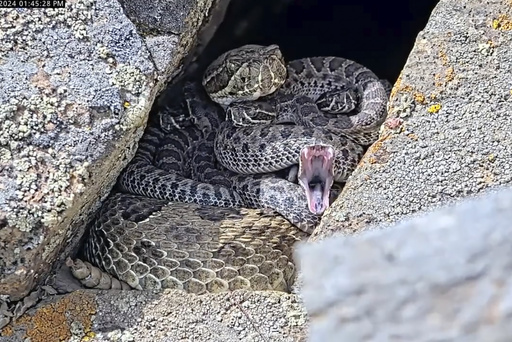
A significant den housing hundreds of rattlesnakes in Colorado is expanding as the late summer season arrives and newborns are welcomed. Scientists are delving into the mysterious world of these often misunderstood reptiles with the help of livestream video from the den located on a rugged hillside in Colorado. Through the video feed, researchers are gaining insights into the behavior of these snakes, especially the young ones, referred to as pups, as they navigate around adult females on rocks covered in lichen.
The Project RattleCam website allows the public to join in and contribute to the valuable research, including helping identify individual snakes. Since the remote camera went online in May, some snakes have become known by names like “Woodstock,” “Thea,” and “Agent 008” both in a chatroom and to the scientists. This collaborative project involves California Polytechnic State University, Central Coast Snake Services, and Dickinson College, with the goal of educating the public and dispelling myths surrounding the perceived ferocity of rattlesnakes.
Contrary to popular belief, rattlesnakes are not typically aggressive and only attack when provoked. They are known to care for their young and even for the offspring of other snakes. Adult rattlesnakes nurture and provide warmth to pups from birth until they go into hibernation in mid-autumn. As many as 2,000 rattlesnakes hibernate at the undisclosed Colorado site on private land, where pregnant females stay during warmer months while others venture into nearby areas.
Researchers have observed fascinating behaviors at the Colorado den this year, such as rattlesnakes coiling up to catch drops of water to drink and reacting to birds attempting to prey on them. The peak of summer activity occurs in late August and early September when newborn rattlesnakes are welcomed over a two-week span. These prairie rattlesnakes are among the 36 species of rattlesnakes found primarily in the U.S., especially in the Southwest and central and western regions. One striking fact is that rattlesnakes birth live young rather than laying eggs, with an average brood size of eight based on the snake’s size.
Research focuses on the impact of temperature changes and ultraviolet sunlight on snake behavior and the social dynamics within rattlesnake families. The live feed from the den is constantly monitored by scientists, with the participation of up to 500 online viewers at a time. The aim is to understand the natural behavior of rattlesnakes undisturbed by human interference. As the Rocky Mountain summer transitions to cooler temperatures, male rattlesnakes are returning. The camera, powered by solar and battery, will be shut down by November but will resume next spring when the snakes emerge from their den.
